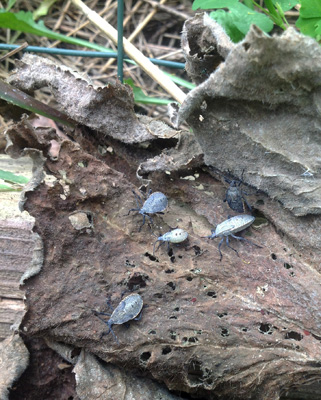Act this fall to deter squash bugs, a serious pest of pumpkins and other squash
Disappointed with this year’s pumpkin harvest? Protect next year’s pumpkins and other squash from squash bugs with a little diligence this fall.
Growing your own pumpkins for Halloween or to use in pies is a fun experience as you watch them develop over the summer and fall. It may be a challenge to keep them safe from deer and raccoons, but it is not only the big critters that can harm your pumpkins. One of the most common pests of pumpkins and squash are squash bugs, Anasa tristis.
The squash bug has piercing-sucking mouthparts that it uses to penetrate plant tissue, sucking the sap from leaves and developing fruit. Their feeding causes small, yellow spots on leaves that eventually turn brown. Heavy feeding can cause leaves to blacken and dry out. Plants wilt as the flow of water is disrupted. This browning can be confused with a bacterial wilt disease that also attacks cucurbits.

Photo credit: Alice Owings and Bob Bricault, MSU Extension
According to Michigan State University Extension, squash bugs can still be found on plants into the fall, as seen in the photo. They survive the winter by hiding in plant debris in the garden, under rocks, or any area that provides protection. The adults that survive the winter emerge in spring to mate and lay eggs directly onto leaves of young squash and pumpkin plants. Bronze, oval-shaped eggs laid in clumps are easy to spot on the undersides of leaves. Young nymphs that hatch from the eggs will feed on the plants throughout the rest of the spring and summer as they develop into adult insects. They are not hard to find since they tend to feed in groups. Nymphs start out a pale green color and molt in later stages into larger gray nymphs, and finally change into gray-to-black adult squash bugs.

Photo credit: Gerald Holmes, Valent USA Corporation, Bugwood.org
Controlling squash bugs in the home garden starts now, in the fall. Removal of debris in and around the garden, including old plants, will reduce the areas where the adult bugs can hide and survive the winter. Once spring arrives managing this pest is more direct. Check for eggs on undersides of leaves and remove them before they can hatch and cause damage. The smart gardener will continue to scout their pumpkins and squash plants from spring to mid-summer, searching for nymphs and eliminating them as they are found.
Boards placed in the garden near the plants, provides squash bugs a place to hide on a cool night. These boards can be checked in the morning for squash bugs, which can then be easily eliminated. Diligent scouting and eliminating this pest early in the season will improve your success for a great harvest. Colorado State University Extension provides more in-depth control measures for squash bugs.
For more facts on squash bugs and other pests of the garden check the Michigan State University Extension News page for gardeners or the Gardening in Michigan website. Taking the time on a beautiful autumn day to clean out debris in your garden can go far to protecting next year’s garden from insects and disease.



 Print
Print Email
Email




